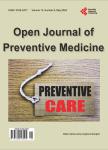Evaluation of the Effectiveness of Workplace Health Promotion Programs from 2000 to 2020: Literature Review
Evaluation of the Effectiveness of Workplace Health Promotion Programs from 2000 to 2020: Literature Review作者机构:Health Promotion and Occupational Epidemiology Department National Institute for Safety and Health at Work Madrid Spain National Centre for Working Conditions National Institute for Safety and Health at Work Barcelona Spain
出 版 物:《Open Journal of Preventive Medicine》 (预防医学期刊(英文))
年 卷 期:2021年第11卷第4期
页 面:113-131页
学科分类:1004[医学-公共卫生与预防医学(可授医学、理学学位)] 100402[医学-劳动卫生与环境卫生学] 10[医学]
主 题:Occupational Health Health Promotion Effectiveness Evaluation
摘 要:Introduction. Recognition of best practices in workplace health promotion is an important task that significantly affects the expansion of those programs. Once the program has been developed, its effectiveness becomes the most critical point of evaluation to guarantee achievements in the improvement of workers’ health. Objectives. To identify the practices for evaluating the effectiveness of workplace health promotion programs. Material and Methods: A search was performed on MEDLINE through PubMed with the MeSH: “Occupational Health, “Health Promotion and “Program Evaluation, from the year 2000 to the year 2020 for studies with the following designs: Meta-analyses, Systematic reviews, Randomized Clinical Trials and Clinical Trials. Results: The most common topic of workplace health promotion programs (WHP) was increasing physical activity and avoiding a sedentary lifestyle, followed by stress management and finally smoking cessation and musculoskeletal disorders. The post-intervention measurements were most often done at 6 months and 12. The most commonly used indicators were the number of steps, weight, BMI, % body fat, waist circumference, blood pressure, sedentary time, level of physical activity and time of moderate-vigorous physical activity, daily energy output, life purpose, life satisfaction, mood and stress level. Conclusions: Although a great variability was observed in the evaluation of WHP programs, there were also common aspects. These results will help with designing WHP programs and defining evidence-based evaluation of their effectiveness. It is important to remember that WHP programs must be customized, taking into consideration the needs of each organization’s workforce.



